Files in this item
What makes a star turn violent? : exploring high-mass star formation and stellar magnetic helicity
Item metadata
| dc.contributor.advisor | Bonnell, Ian Alexander | |
| dc.contributor.advisor | Wood, Kenny | |
| dc.contributor.advisor | Jardine, Moira | |
| dc.contributor.author | Lund, Kristin | |
| dc.coverage.spatial | xxx, 200 p. | en_US |
| dc.date.accessioned | 2021-09-16T16:15:13Z | |
| dc.date.available | 2021-09-16T16:15:13Z | |
| dc.date.issued | 2020-12-01 | |
| dc.identifier.uri | https://hdl.handle.net/10023/23973 | |
| dc.description.abstract | High-mass stars play an important role in both the dynamical and chemical evolution of the galaxy, hence how they form has long been a topic of interest. In this thesis I explore accretion as a possible means of forming high-mass stars. I use a radiation hydrodynamics code to simulate accretion onto a star which emits ionising radiation. Usually accretion is assumed to end once ionisation begins, however I find accretion continues through the ionisation front whilst the ionised region is gravitationally trapped. This extended period of accretion increases the amount of material added to the star. As most high-mass stars are observed in close binary systems, next I develop a semi-analytic model to investigate whether accretion onto wide lowmass binaries can increase the mass of the stars and simultaneously decrease their separation. The result suggests magnetic braking of the accretion flow is a feasible way of forming the most massive close binary systems. The second part of this thesis focuses on the magnetic helicity density of low-mass stars. There has been growing interest in magnetic helicity as a potential tracer of stellar eruptions, but measurements based on observations have been limited to the Sun. I present an analytic expression for the magnetic helicity density across any stellar surface given only observable quantities. This expression is used to calculate the magnetic helicity density of 52 stars, which is then plotted against other stellar parameters. I find mostly different behaviours for the partially and largely convective stars, except when plotting helicity density against toroidal magnetic energy. In that case the entire stellar sample follows the same power law. Comparing the Sun to the other stars I find the variation in solar helicity densities across a solar cycle falls within the scatter of the stellar values. | en_US |
| dc.description.sponsorship | "This work was supported by the Carnegie Trust for the Universities of Scotland through a Carnegie PhD Scholarship." -- Funding | en |
| dc.language.iso | en | en_US |
| dc.publisher | University of St Andrews | |
| dc.relation | What makes a star turn violent? Exploring high-mass star formation and stellar magnetic helicity (thesis data) Lund, K., University of St Andrews, 2020. DOI: https://doi.org/10.17630/eeb14f5f-11a0-40d0-8ae0-f9075ec28363 | en |
| dc.relation.uri | https://doi.org/10.17630/eeb14f5f-11a0-40d0-8ae0-f9075ec28363 | |
| dc.subject.lcc | QB806.L86 | |
| dc.subject.lcsh | Stars--Formation | en |
| dc.subject.lcsh | Stars--Magnetic fields | en |
| dc.title | What makes a star turn violent? : exploring high-mass star formation and stellar magnetic helicity | en_US |
| dc.type | Thesis | en_US |
| dc.contributor.sponsor | Carnegie Trust for the Universities of Scotland | en_US |
| dc.type.qualificationlevel | Doctoral | en_US |
| dc.type.qualificationname | PhD Doctor of Philosophy | en_US |
| dc.publisher.institution | The University of St Andrews | en_US |
| dc.identifier.doi | https://doi.org/10.17630/sta/136 |
The following licence files are associated with this item:
This item appears in the following Collection(s)
Items in the St Andrews Research Repository are protected by copyright, with all rights reserved, unless otherwise indicated.

